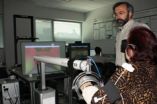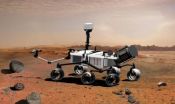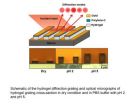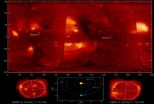(Press-News.org) The Journal of the American Medical Society ("Medical News & Perspectives", Jan. 19, 2011) featured the research of NJIT Associate Professor Sergei Adamovich, a biomedical engineer. Adamovich and his research partners, physical therapists Alma Merians, PhD, PT, and Eugene Tunik, PhD, PT, at the University of Medicine and Dentistry of New Jersey, have developed innovative robotic and virtual reality-based video game therapies to help stroke patients regain use of hands and arms.
JAMA reported that the efforts of this team are making headway. Twenty-four patients who completed the program report improvements completing daily tasks. One patient reported cutting strawberries with both hands without realizing it, something she had previously been unable to do. A $1.3 million grant from the National Institutes of Health (NIH) supports this research. (EDITORS: To interview Adamovich, call Sheryl Weinstein, 973-596-3436)
The article noted that patients in the program underwent about 22 hours of practice using a library of virtual reality video games designed by Adamovich's group. Clinical tests of arm and hand function showed improvement. Adamovich attributed the program's success to the increased intensity of repetitions and interesting exercises. With the assistance of the robotic arm, a key component of the program, the patient may complete many more repetitions than in the usual clinical setting. The researchers also analyzed brain activity before and after training and believe their work is making key neurological changes.
Last fall, the researchers reported their work to the media at a press conference at the Society for Neuroscience Conference, the world's largest source of emerging news on brain science and health in San Diego, CA. More volunteers are continually needed for the study. For information about requirements, contact Gerard G. Fluet, DPT, (732) 986-8621, fluet179@comcast.net.
"Strokes are the largest cause of disability in adults in the U.S.," Adamovich said. "That's why we feel our research is important. More people than ever survive strokes and live longer lives, but they are hobbled by major disabilities. We would like to see that change and give stroke patients the opportunity to live better lives."
While other researchers around the nation have pursued similar therapies, only a few currently focus on hand functions. Adamovich's team is trying to determine whether it is better to train the hand and arm separately or together.
Two at a time, subjects come to Adamovich's sixth-floor laboratory in Fenster Hall on the NJIT campus. Once there, they spend up to three hours a day, five days a week, for two weeks to play the specialized video games. In one game, their arms are attached to a robot called the Haptic Master. The robot, supporting their weakened arms, enables them to touch virtual spheres, which if done correctly will explode with a satisfying boom. At first glance, the uninitiated might imagine he has stepped into a video arcade. For finger-strengthening exercises, subjects in another room play a simulated piano keyboard on a wall-hung computer screen.
Interestingly, the researchers want subjects as young as 25 and as old as 80. "Age makes no difference when it comes to making improvements," Adamovich adds. Even more surprising, they've had people come to them as many as 15 years past their strokes and make even better progress than individuals six months after the event.
Today's work is based upon a research paper by Adamovich that appeared in 2006: "Sensorimotor training in a virtual reality environment: Does it improve functional recovery post-stroke?" (Neurorehabilitation and Neural Repair). The paper detailed an earlier version of what's in his lab today. "We weren't using the kinds of robotic arms that we have now," said Adamovich. "Subjects played computer games using hand/finger motions in a special glove capable of measuring their finger movements." Additionally, the training used only hands, unlike now, in which the technology has enabled hand-training to be combined with robot-assisted elbow and shoulder-training.
Adamovich, a physicist by education, began studying how the brain controls hand and arm function because of an underlying interest in the basic research principles of brain and body movement, planning and execution. Several years ago, he moved into applied research. "We believe that motor control and learning are important when trying to understand rehabilitation," he said. "Neuroscience has demonstrated through animal studies that you can induce changes in adult brain networks through intensive stimulation and sensory motor training. And, thanks to the recent changes in technology—especially the availability of robots—this whole area of neuro-rehabilitation has taken off."
INFORMATION:
NJIT, New Jersey's science and technology university, enrolls more than 8,900 students pursuing bachelor's, master's and doctoral degrees in 120 programs. The university consists of six colleges: Newark College of Engineering, College of Architecture and Design, College of Science and Liberal Arts, School of Management, College of Computing Sciences and Albert Dorman Honors College. U.S. News & World Report's 2010 Annual Guide to America's Best Colleges ranked NJIT in the top tier of national research universities. NJIT is internationally recognized for being at the edge in knowledge in architecture, applied mathematics, wireless communications and networking, solar physics, advanced engineered particulate materials, nanotechnology, neural engineering and e-learning. Many courses and certificate programs, as well as graduate degrees, are available online through the Office of Continuing Professional Education.
Contact: Sheryl Weinstein, director, public relations, Sheryl.m.weinstein@njit.edu, 973-596-3436.
JAMA features NJIT biomedical engineer helping stroke patients
2011-02-09
ELSE PRESS RELEASES FROM THIS DATE:
Why leatherback turtles linger in South Pacific Gyre, and why it matters
2011-02-09
VIDEO:
Tagging and tracking leatherback sea turtles has produced new insights into the turtles' behavior in a part of the South Pacific Ocean long considered an oceanic desert. The new data...
Click here for more information.
Leatherbacks. They are the Olympians of the turtle world – swimming farther, diving deeper and venturing into colder waters than any other marine turtle species. But for all their toughness, they have still suffered a 90 percent drop in their population ...
Tool makes search for Martian life easier
2011-02-09
RICHLAND, Wash. – Finding life on Mars could get easier with a creative adaption to a common analytical tool that can be installed directly on the robotic arm of a space rover.
In a recent paper published online in the journal Planetary and Space Science, a team of researchers propose adding a laser and an ion funnel to a widely used scientific instrument, the mass spectrometer, to analyze the surfaces of rocks and other samples directly on Mars' surface. The researchers demonstrated that the combined system could work on the spot, without the sample handling that mass ...
Hydrogels used to make precise new sensor
2011-02-09
WEST LAFAYETTE, Ind. - Researchers are developing a new type of biological and chemical sensor that has few moving parts, is low-cost and yet highly sensitive, sturdy and long-lasting.
The "diffraction-based" sensors are made of thin stripes of a gelatinous material called a hydrogel, which expands and contracts depending on the acidity of its environment.
Recent research findings have demonstrated that the sensor can be used to precisely determine pH - a measure of how acidic or basic a liquid is - revealing information about substances in liquid environments, said ...
Detecting pathogens in waterways: An improved approach
2011-02-09
This press release is available in Spanish.
U.S. Department of Agriculture (USDA) scientists have come up with a way to detect pathogenic Escherichia coli and Salmonella bacteria in waterways at lower levels than any previous method. Similar methods have been developed to detect pathogenic E. coli in meat products, but the approach by the scientists with USDA's Agricultural Research Service (ARS) represents a first for waterways.
ARS is USDA's principal intramural scientific research agency, and this research supports the USDA priority of ensuring food safety.
When ...
UT Study: Charismatic leadership can be measured, learned
2011-02-09
KNOXVILLE -- How do you measure charisma? That's the question UT professor Kenneth Levine seeks to answer.
Much has been written in business management textbooks and self-help guides about the role that personal charisma plays in leadership. But according to a newly published study co-authored by Levine, a University of Tennessee, Knoxville, communications studies professor, until recently no one was able to describe and measure charisma in a systematic way.
Levine said the large amount of academic literature on charismatic leadership never defined what it means to ...
The hitch in the drug? The itch in the drug
2011-02-09
Scratching deep beneath the surface, a team of researchers from the University of California, San Diego School of Medicine and three South Korean institutions have identified two distinct neuronal signaling pathways activated by a topical cream used to treat a variety of skin diseases. One pathway produces the therapeutic benefit; the other induces severe itching as a side effect.
The findings, published in this week's early online edition of the Proceedings of the National Academy of Sciences, point to the possibility of designing future drugs that effectively treat ...
Dramatic improvement in Parkinson disease symptoms
2011-02-09
New Rochelle, NY, February 8, 2011—Successful intranasal delivery of stem cells to the brains of rats with Parkinson disease yielded significant improvement in motor function and reversed the dopamine deficiency characteristic of the disease. These highly promising findings, reported in Rejuvenation Research, a peer-reviewed journal published by Mary Ann Liebert, Inc. highlight the potential for a noninvasive approach to cell therapy delivery in Parkinson disease–a safer and effective alternative to surgical transplantation of stem cells. The article is available free online. ...
NRL researchers view the sun in 3-D
2011-02-09
Beginning on February 6, 2011, the two STEREO spacecraft are 180 degrees apart providing Naval Research Laboratory (NRL) scientists with a 360-degree view of the Sun. NASA's STEREO (Solar Terrestrial Relations Observatory) spacecraft were launched on October 25, 2006, and have been gathering spectacular images of solar activity, especially solar storms, since the mission began.
A key component of the STEREO mission is NRL's Sun Earth Connection Coronal and Heliospheric Investigation (SECCHI), a suite of five scientific telescopes that observe the solar corona and inner ...
Scientists develop method to identify fleetingly ordered protein structures
2011-02-09
LA JOLLA, CA – February 8, 2011 - A team of scientists from The Scripps Research Institute and the University of California, San Diego (UCSD) have developed a novel technique to observe previously unknown details of how folded structures are formed from an intrinsically disordered protein. The insights could help scientists to better understand the mechanism of plaque formation in neurodegenerative disorders such as Parkinson's and Alzheimer's diseases.
The results of the study, which has broad implications for the field, were recently published in an advanced, online ...
New techniques for stapling peptides could spur development of drugs for cancer
2011-02-09
BUFFALO, N.Y. -- Researchers at the University at Buffalo have devised two new ways of "stapling" peptide helices to prevent these medically important molecules from losing their shape and degrading in the presence of enzymes.
The discovery could help speed the development of peptide-based drugs against diseases including cancer. UB scientists say the methods they pioneered are simpler than existing techniques, one of which employs an expensive ruthenium catalyst to connect chemical side chains that protrude from the main body of helical peptides.
"There's a lot of potential ...



